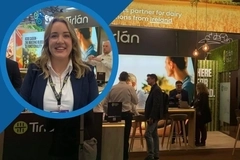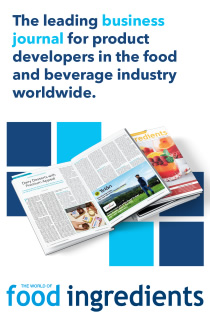
- Industry news
Industry news
- Category news
Category news
- Reports
- Key trends
- Multimedia
- Journal
- Events
- Suppliers
- Home
- Industry news
Industry news
- Category news
Category news
- Reports
- Key trends
- Multimedia
- Events
- Suppliers
Savor, Alamance and Thimus serve up CO2-based, palm-free whipped cream for alt-dairy
US-based Savor has developed a palm-oil-free whipped cream using its CO2-based fat technology in collaboration with Alamance, a whipped dairy firm, and sensory neuroscience company Thimus. The technology’s versatility allows the “infinite customization” of fatty acid profiles to formulate a range of products — from “dairy-like” butter to sustainable palm oil alternatives.
The companies debuted the palm-free whipped cream prototype at Future Food‑Tech Chicago earlier this month. After a three‑week sprint to develop a whipped topping, they say taste testers preferred it over traditional palm oil versions.
Savor uses a thermochemical process to convert point-captured CO₂, green hydrogen, and methane into sustainable fatty acids, which are then combined into high-quality fats like whipped toppings for food applications.
The process uses controlled temperature and pressure to produce triglycerides, the main components of fats. The partnership combined the process with Alamance’s R&D techniques and Thimus’ sensory evaluation methods.
Food Ingredients First speaks with the companies to explore their innovative collaboration, the challenges in scaling production, and future plans for creating carbon-neutral fats.
Savor aimed to demonstrate the real-world application of its “carbon-neutral fat technology” in a popular consumer product like whipped cream with this collaboration, says Pierre Coeurdeuil, senior manager of Strategic Partnerships.
Coeurdeuil says Savor aims to make sustainable fat production scalable and cost-effective, and a clear choice for food manufacturers.“Our primary objective was to prove that our fat could seamlessly integrate into existing food manufacturing processes while delivering superior performance compared to traditional fat — in this case, palm oil used in whipped toppings.”
“Working with Alamance’s established manufacturing expertise and Thimus’ sensory evaluation capabilities allowed us to quickly validate our fat’s viability for a particular use case in just three weeks — something that would typically take months or years in traditional R&D cycles.”
Alamance provided its technical expertise in aerosol food systems and in-house innovation hub AFI Labs to develop a whipped topping “aligned with both sustainability and consumer expectations,” Nick Patrick, director of business development at Alamance, tells us.
He adds that the partnership enables a deeper understanding of “emotional drivers behind product experiences.”
“From there, we move quickly — aligning on shared technical goals, rapid prototyping, and commercial scalability. These partnerships allow us to push the boundaries of flavor, functionality, and consumer connection in a way that’s human and highly actionable.”
Tapping neuroscience
Thimus used its sensory neuroscience platform, T-Box, to gather real-time consumer and sensory insights into the product prototypes.
Thimus’ T-Box platform measures product likeability at one-second intervals, enabling companies to adjust aspects like taste and texture based on real-time feedback, says Ubiali.“Sensory neuroscience as deployed in Thimus’ T-Box platform influences the way products are developed in a very technical sense as well as in a more holistic one,” explains Mario Ubiali, founder and CEO of Thimus. “By quickly testing untrained consumers’ emotional responses, manufacturers can iterate faster and reduce product development cycles by nearly 50%.”
Thimus compared the levels of likeability and familiarity when consumers tasted the no-palm versus the palm samples, and demonstrated that based on solid scientific data, the new product — if launched — would “not just show parity but actually perform better than the traditional one.”
“Specifically, we showed with our data time resolution that the higher likeability of the Savor-based product was, in fact, very clear at the end of the tasting phase and then in the aftertaste.”
“This shows that the mouthfeel was just perfectly aligned with the expectation of indulgence people have with whipped products,” adds Ubiali.
Eyeing carbon neutrality
The product also aims to mitigate the issues linked to palm oil, which Coeurdeuil affirms is one of the “most pressing sustainability challenges” in food manufacturing today. It is still widely used because of its functional properties and cost-effectiveness.
The whipped cream aims to match or exceed palm oil’s properties, like whipping, mouthfeel, and stability.
Patrick says the partnership allows for a deeper understanding of the “emotional” drivers behind product experiences.While palm-free, the “Minimum Viable Product” developed by the teams isn’t yet carbon-neutral, which remains the ultimate goal, says Coeurdeuil.
For Patrick, sustainability in dairy is about exploring opportunities to “advance traditional dairy and integrate new technologies.”
“On one end, innovations like carbon capture — as seen in our partnership with Savor — allow us to reimagine ingredient sourcing with a lower environmental footprint. At the same time, we continue to support and work alongside dairy producers to improve efficiency, reduce waste, and extend product life through packaging and process improvements.”
Reducing conventional fat reliance
Savor commercially launched its animal- and plant-free butter in April. Coeurdeuil tells us it is looking at working with customers such as Michelin-star restaurants SingleThread and ONE65 and bakeries like Jane the Bakery this year.
Savor has also caught the interest of CPG multinationals collaborating on ingredient innovation and adapting its customizable fat technology to meet manufacturers’ specific needs.
“This whipped topping collaboration with Alamance is just a snapshot of what we can do in partnership with companies producing a range of products across baked goods, confectionery, dairy alternatives, and countless other verticals that currently rely on conventional fats,” says Coeurdeuil.
“Our goal is to make sustainable fat production scalable and cost-effective enough that choosing the environmentally responsible option becomes the obvious business decision for food manufacturers with whom we work,” he concludes.

















